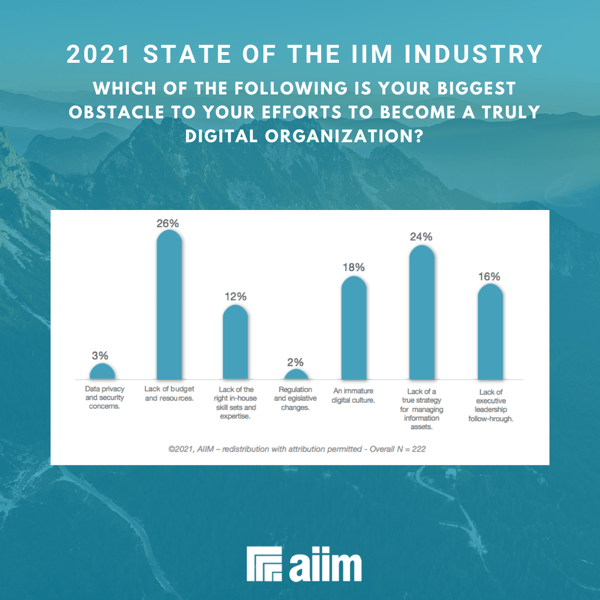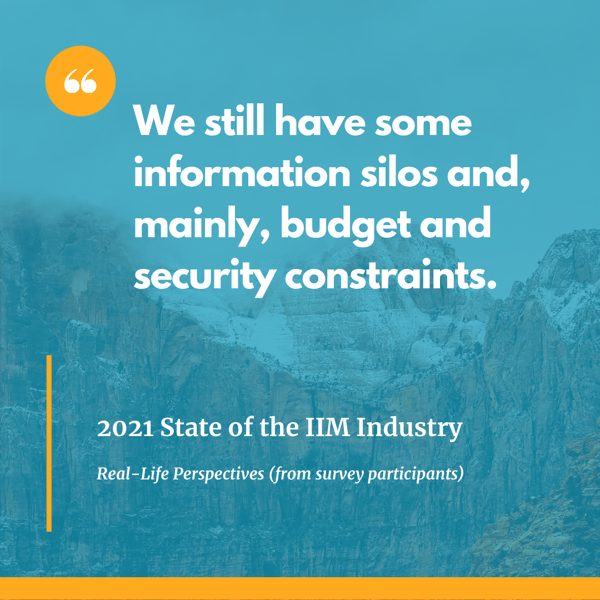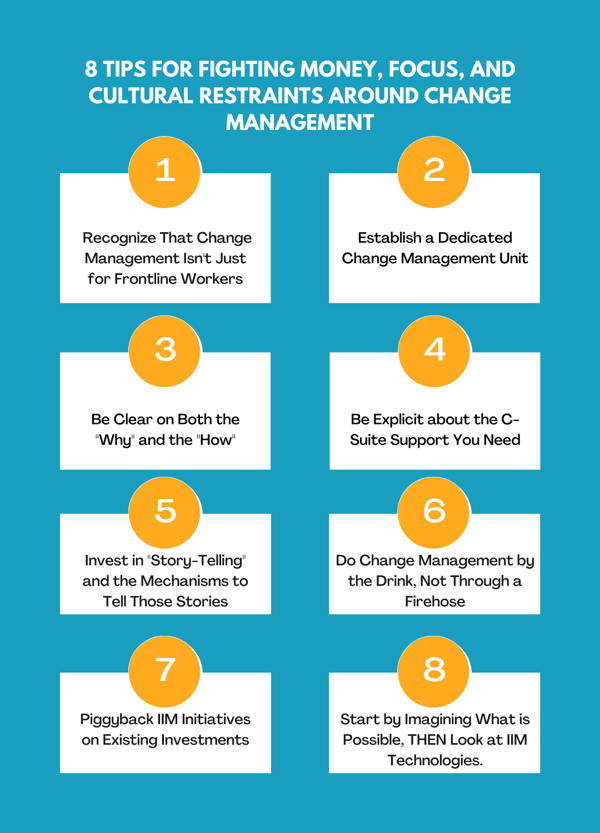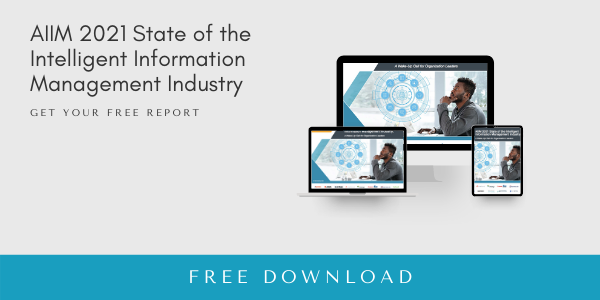
Successful Information Management: What's Standing in Your Way?
Intelligent Information Management (IIM)
One would think that the rapid pace of changing technology is the primary struggle for organizations on their journey to transforming into a truly digital organization. However, based on our recent state of the intelligent information management industry research, that is simply not the case. At the top of the list of true obstacles that organizations face is money – "lack of budget and resources" (26%). This is followed by a "lack of a true strategy for managing information assets" (24%), and "an immature culture" (18%).
Here's a look at the data from the research:

Here's what some IIM professionals had to say on the matter. These quotes are from survey participants showing real-life perspectives:
- "Those who say "we've always done it this way" are not forward-thinking and hold back progress. Open-mindedness is necessary to make sure we are moving forward and we must rise to the challenge, not shrink back from it."
- "Each department is doing their own thing, creating multiple duplicates of the same content, and also inconsistent practices within each department on what and how information is captured."
- "Senior executives seem uninterested in information management. Most of the time they are not interested in any information management agendas."

8 Tips for Fighting Money, Focus, and Cultural Restraints Around Change Management
So what can you do about it? Here are six tips for fighting money, focus, and cultural restraints around change management projects:

1. Recognize That Change Management Isn't Just for Frontline Workers
You can have some great, fantastic ideas about what you want to do with information, but you need to be able to educate everyone up and down the stack about what you are planning. You need to be able to go to that frontline worker and explain what's in it for them, but you also need to be able to explain to the C-Suite what's in it for them.
2. Establish a Dedicated Change Management Unit
Assign a project management office (PMO) for migrations and upgrades to make sure that content is both transferred and available to customer specifications. This PMO should meet with the customer, develop business requirements and success criteria, and shepherd the process with customer input through to completion.
3. Be Clear on Both the "Why" and the "How"
Educate potentially stressed individuals on why changes need to occur. Especially when automating, it is important for the individuals to understand how the information management solution will improve their work environment by eliminating tedious tasks in order to gain their support. But don't stop there. Once you have established the reason for change, be very clear on how and when it will evolve.
4. Be Explicit about the C-Suite Support You Need
Bring enterprise-wide initiatives to senior executives before investing any time in implementation. Give them a countdown of activities that are expected, so there are no surprises. State explicitly: "This is what we need from you." Do not assume they will know what you expect them to do.
5. Invest in "Story-Telling" and the Mechanisms to Tell Those Stories
It is not enough to talk about the technical reasons why a particular change is being made or why a new system is being implemented. Think like a marketer; actively market what you are doing. One survey participant shared their experience:
"We didn't launch an awareness campaign on records and information governance until just a few years ago. Looking back, I wish I would have done that sooner; I had an opportunity, so I ran with it. And now we're in our third year of that program. It's really been amazing how many people are paying attention now; I wish I had done this earlier."
6. Do Change Management by the Drink, Not Through a Firehose
Communicate the change early, and provide training opportunities and time for feedback. Introduce change in small increments and be inclusive with the business users who will be impacted by the change. Break down the issue into steps/pieces and align each piece with a complete understanding of the technology.
7. Piggyback IIM Initiatives on Existing Investments
Rather than buying an entirely new application, speak to IT about applications the organization already owns that can be repurposed or enhanced with IIM capabilities. Offer “consulting services” to a team to formulate the groundwork and build a goodwill. Once a team is on board, use the success and word of mouth to bring attention to the organization about IIM.
8. Start by imagining what is possible, THEN look at IIM technologies
Business people need to commit to enough technology competency to imagine what could be possible. And once they have imagined what is possible from a business perspective, only then look at technologies. How does the technology fit in with the business outcome that we imagine? Unfortunately, things often evolve exactly backwards. Somebody rolls in with a truck full of software and says, “GO!”

More on Change Management
Regardless of the kind of change, whether technological, cultural, procedural, role-based, or any other, it must first be decided if an organization is ready to face the change and adjust to it. Change may be coming whether it’s welcome or not. Determining readiness is a big factor in the potential success of your information management project. Organizational change is always going to appear threatening to people as it is often linked to job security. Some enterprises freely disseminate information regarding strategy changes. Other firms are very secretive and feel that this is for senior management only. Practitioners should be as open and honest with staff about change as they possibly can. Typically, people will more readily embrace the change process if clear information is available
For more on change management and the state of Intelligent Information Management industry, check out this analyst briefing video. In it, John Mancini takes a deep look at what the data is telling us are the most important topics in our industry for 2021 and beyond.
Download the Report
Using a web-based tool in February 2021, nearly 300 executives weighed in on the research study. All the participants were drawn from the AIIM Community. This is important because it means the responses are from an informed audience that understands the benefits – and the reality – of information management in their organizations. Get your Free copy of the report.



